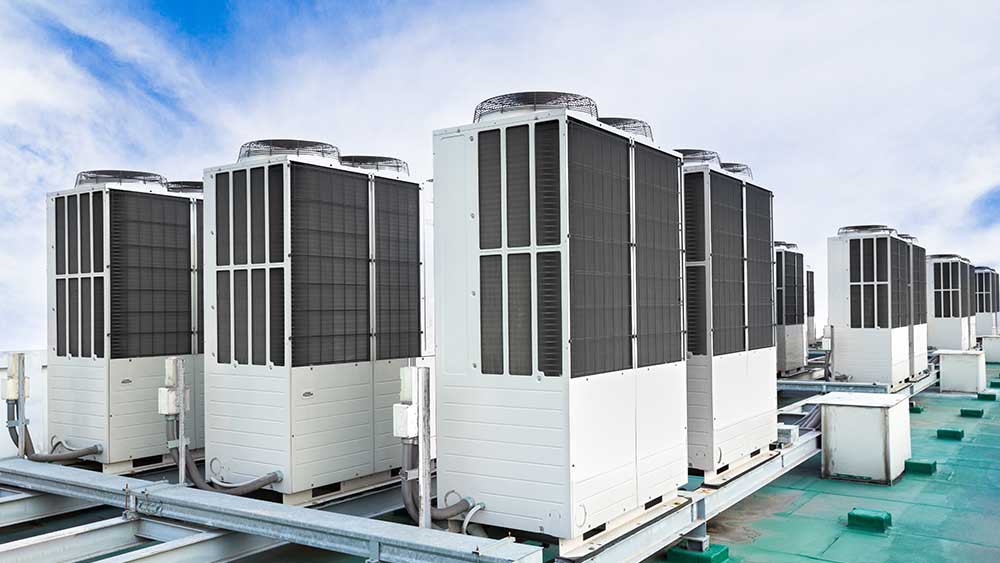
Key Takeaways
- Commercial HVAC systems come in various types, i.e., packaged units, split systems, heat pumps, and VRF/VRV.
- Integrating smart thermostats with your HVAC system allows for automated temperature control and savings.
- While commercial HVAC maintenance may seem costly, it significantly reduces energy bills and extends system lifespan.
Commercial HVAC systems are a crucial aspect of any building. Temperature maintenance, humidity, air quality, and so much more is dependent on a well-functioning HVAC system. If it fails, you can face an unfortunate loss in income, repairs, and clientele. This makes it extremely important to keep these systems well-maintained and swinging throughout the year.
Due to their large scale, commercial heating and cooling systems can be complex and difficult to understand. Here is an easy breakdown of everything you need to know to keep commercial air conditioners in excellent condition!
- Key Components of Commercial HVAC Systems
- Types of Commercial HVAC Systems
- Make Any Commercial Cooling & Heating Equipment Smart
- How to Choose a Suitable Commercial HVAC System?
- Is Commercial Building HVAC System Maintenance Worth the Expense?
- How Do Commercial Air Conditioners Differ From Residential Systems?
Key Components of Commercial HVAC Systems
There are several different types of commercial heating and cooling systems, but all of them have the following essential components:
1. Air Conditioning Unit
This part of a commercial HVAC system is responsible for lowering or raising the temperature inside a building by working with other subsystems.
2. Air Handler
The air handler blows out chilled or warmed air in the building and then returns the air back into the system. It has evaporator coils containing refrigerant and a blower.
3. Compressor
This is a very important part of an HVAC system. It changes the volume, density, and temperature of the refrigerant.
4. Condenser
The condenser receives the refrigerant from the compressor and turns it into liquid. This serves as the heat exchanger of the HVAC system. When cooling, it expels heat from your building, and when heating, it collects heat from the outdoors.
5. Thermal Expansion Valve
This cools down the liquid refrigerant to be pumped back into the coils.
6. Terminal Units
These units control the amount of air entering each zone through ducts. They also have air filters to keep air dirt and debris free.
7. Thermostat
It signals your HVAC system to produce cool or hot air based on the set temperature range. Commercial buildings may have several thermostats installed in various rooms.
8. Ductwork
Most commercial ducted units have a ductwork system that helps distribute conditioned air throughout the building.
9. Chillers
These are the cooling elements of a large commercial HVAC unit. Chillers remove heat from the liquid running through pipes in a building. Some HVAC units have air-cooled chillers, while others have water-cooled chillers.
Types of Commercial HVAC Systems
There are several options for choosing a commercial heating and cooling system. Each type has its advantages and disadvantages, so it’s important to consider your specific needs before deciding. It can get pretty confusing to jot down all the details, so it’s always good to discuss with a professional after narrowing down your options. Let’s look at all the commercial air conditioning types in detail:
1. Packaged Air Conditioner
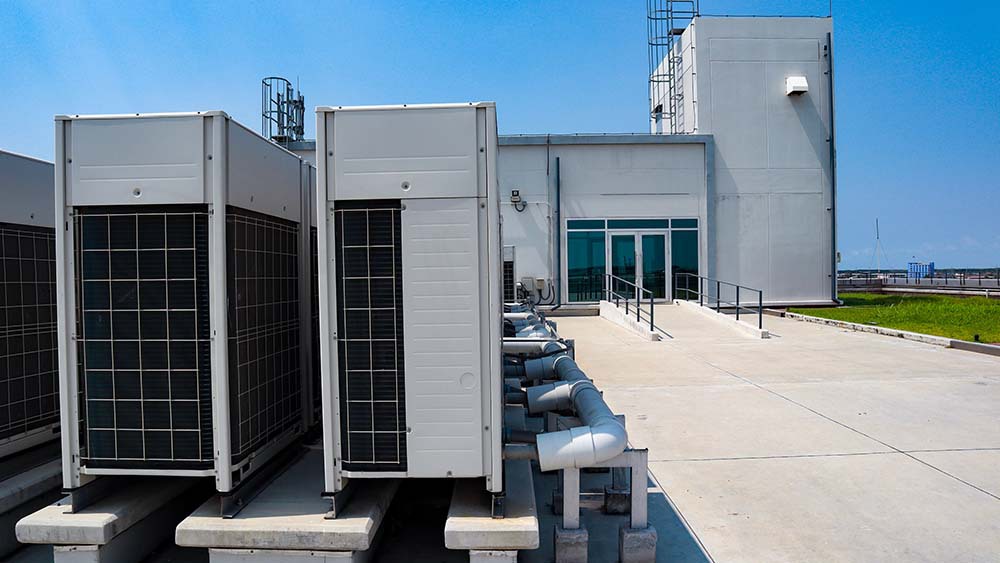
A commercial packaged-air conditioner is similar to a window air conditioner but much bigger in size. These commercial AC units have a higher heating and cooling capacity that ranges from 3 to 15 tonnes.
Packaged ACs have an all-in-one design containing a condenser, compressor, fan coil, and evaporator. These are usually mounted outside or on roofs in buildings such as senior homes, hospitals, and condominiums. The conditioned air is spread throughout the building by a network of ducts hidden in the ceiling.
| PROS | CONS |
| Low installation costs | Limited life span |
| Simple maintenance requirements | High refrigerant costs |
| Quiet operation | High sensitivity to blocked air filters |
2. Split System
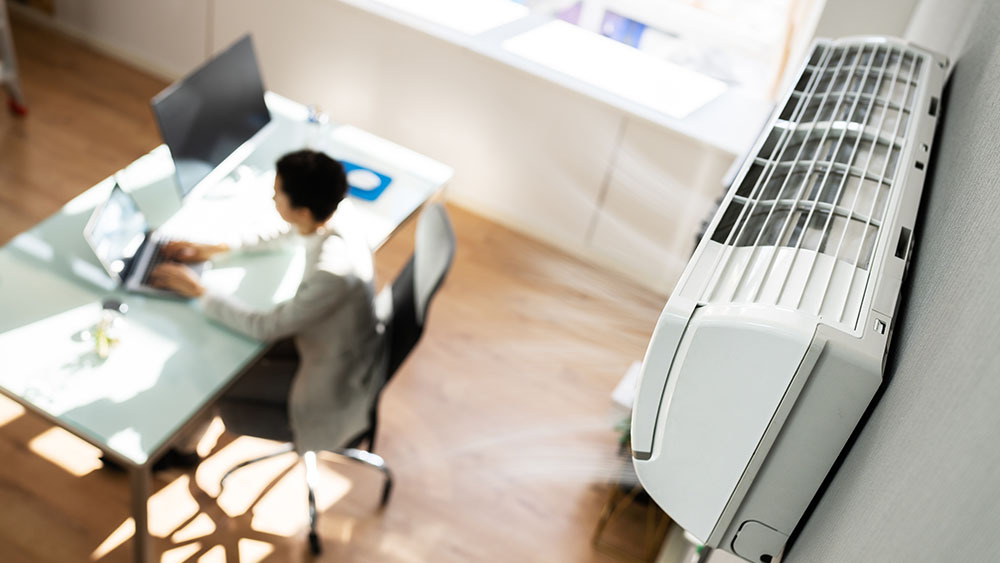
As the name suggests, a split system has two parts; an indoor and an outdoor unit. Commercial split air conditioners further have two types:
- Single-Split System
This is an affordable, energy-efficient commercial heating and cooling option for small buildings, cafes, server rooms, or shops. They are ideal for individual room cooling but can be used in combinations to condition multiple rooms. However, because each air conditioning unit needs a separate outdoor unit, this clutters the external space of the building.
| PROS | CONS |
| Ideal for small spaces | Multiple outdoor units clutter the space |
| Energy efficient | Not suitable for large buildings |
| Can be used as an additional source of air conditioning |
|
| Less expensive to install |
- Multi-Split System
In a multi-split system, one outdoor unit operates multiple inside indoor units. These systems require extensive pipework and, if not installed properly, can reduce the efficiency of your system.
Multi-split system is better suited for medium-sized buildings like restaurants or retail shops.
| PROS | CONS |
| It takes up less space | Higher installation cost |
| Preserves the building’s external appearance | Lots of pipework is needed |
| Ductwork isn’t required | Not suitable for small commercial spaces |
3. Heat Pump

A heat pump heats or cools a building by transferring heat outside in the summers and inside in the winters. Since heat pumps do not generate heat, they can efficiently maintain comfortable temperatures. However, they’re not suitable in areas with extreme climate conditions.
Heat pumps can be ducted as well as ductless. Ducted heat pumps are suitable for larger areas but require extensive ductwork. Ductless heat pumps are ideal for supplemental or individual room cooling.
| PROS | CONS |
| Most energy efficient | Not suitable for colder climates below 40 degrees |
| Require less maintenance | Installing/cleaning ducts can be a hassle |
| Do not produce carbon monoxide | |
| Great for large and medium-sized buildings | |
| Quick installation if ductwork is installed |
4. Variable Refrigerant Flow (VRF) or Variable Refrigerant Volume (VRV)
VRF or VRV is a ductless system that uses the minimum energy to attain the required temperature. It varies the refrigerant volume to match the precise requirements of a building. If the system requires more cooling, more refrigerant will enter the pipes. Because of varied compressor speed and no duct involvement, these units are considered much more efficient than the traditional HVAC units. Its mechanism results in lower energy costs and the long-term sustainability of the unit.
| PROS | CONS | |
| Saves energy bills | Expensive equipment | |
| Suitable for spaces with variable cooling or heating requirements | Takes a lot of space | |
| Better humidity and temperature control | Backup condenser is required in case of a malfunction |
Make Any Commercial Cooling & Heating Equipment Smart
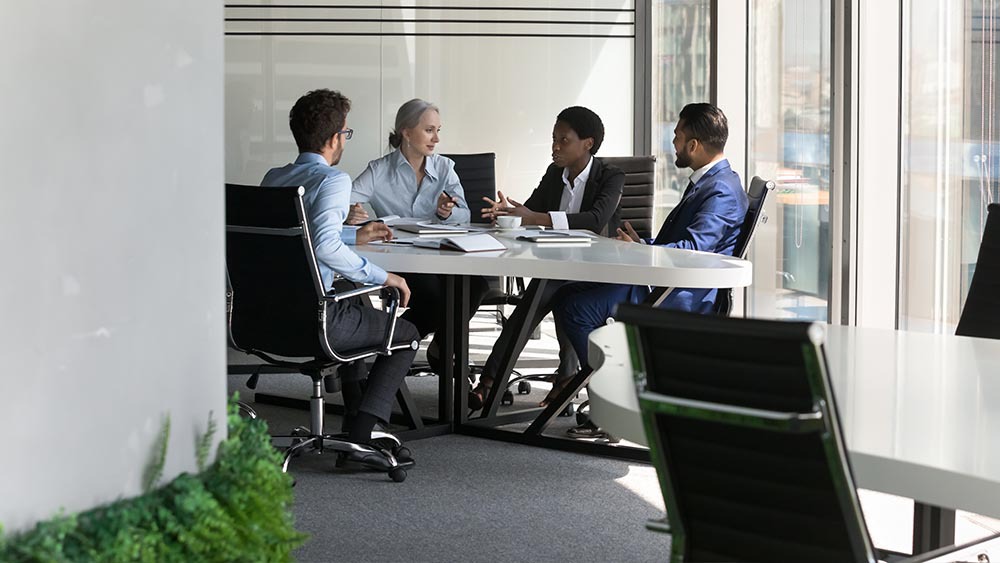
Maintaining a consistent temperature throughout your building while considering the different needs of the inhabitants can be quite challenging and time-consuming. But not if you pair your commercial HVAC system with a smart thermostat (for ducted) or a smart AC controller (for ductless).
These smart devices allow you to automate your building’s climate. You can set schedules and have different settings for different days of the week. Moreover, you can create zones and set customizable temperature regions within the building.
With all the next-gen features like temperature/humidity-based triggers, geofencing, usage history, and much more, you can save up to 25% on energy bills.
Your best choice to make any mini-split, window,
or portable AC smart. Enhance your comfort and savings.

How to Choose a Suitable Commercial HVAC System?
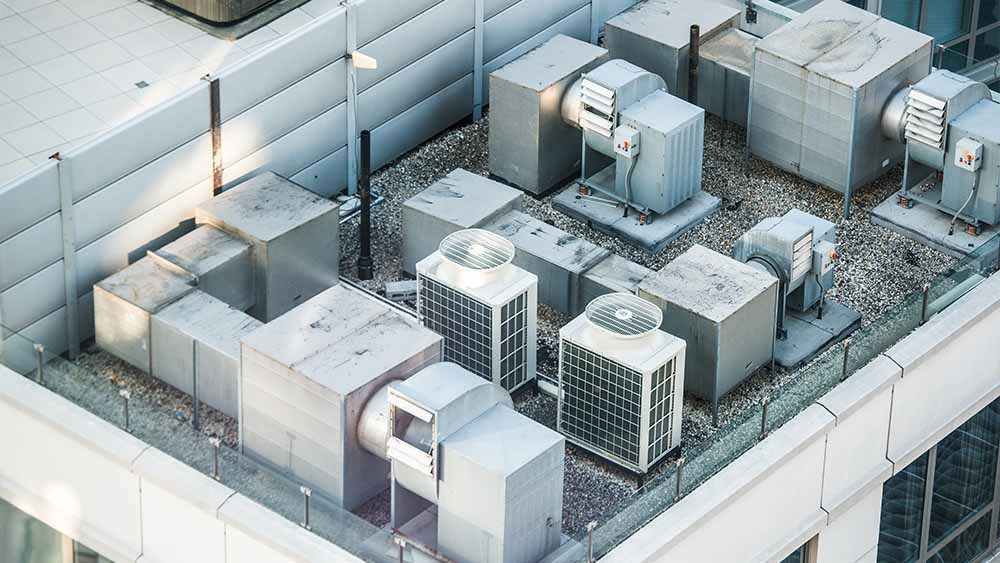
When it comes to choosing an air conditioning unit for commercial use, the following factors are important to consider:
- Building design
- Energy efficiency
- Climate conditions
- Air quality
The first step is to determine the heating and cooling requirements of the space. This will vary depending on the type of business and the number of people that occupy the building. For instance, if your facility includes IT infrastructure, investing in a reliable server room air conditioner is essential.
Next, consider the building’s energy efficiency. In general, newer buildings are better insulated and require less energy to heat and cool. However, older buildings can often be retrofitted with energy-efficient windows, doors, and insulation.
Climate conditions are also an important consideration. For example, mini-splits won’t work when heat waves hit if the building is in an extremely hot and humid climate.
Finally, air quality is another important factor to consider. Indoor air quality can be affected by a number of factors, including off-gassing from building materials, cleaning products, and office equipment. To ensure proper airflow and filtration, it’s important to choose an HVAC system that is sized appropriately for the space and ventilation needs.
Is Commercial Building HVAC System Maintenance Worth the Expense?

A typical commercial building HVAC system is a complex network of air conditioning components, including air ducts, air filters, coils, and blowers. To keep this system running smoothly, it is important to perform regular maintenance.
Usually, commercial HVAC maintenance may be too costly, but it saves a lot in the long run. For example, regular maintenance can extend the durability of your equipment. Additionally, properly maintained HVAC systems tend to have lower operating costs, so you’ll save money on your energy bills each month. Finally, regular maintenance can help ensure the comfort of your tenants or customers by keeping the temperature and humidity always at a comfortable level. When you weigh all the factors, it’s clear that investing in maintenance for your commercial HVAC system is a thrifty decision.
Here are the most important things to tick off your regular HVAC maintenance list:
- Inspect air filters and clean or replace them as needed
- Clean the condenser and evaporator lines
- Check for blockages in the air ducts
- Inspect the drain lines to ensure they’re not clogged
- Test the thermostat readings to make sure it’s accurate
Additionally, follow these detailed commercial HVAC maintenance tips to ensure your system runs smoothly and efficiently throughout the year.
How Do Commercial Air Conditioners Differ From Residential Systems?
When it comes to climate control, commercial HVAC systems are in a class of their own. These heavy-duty systems are designed to cool or heat large spaces quickly and efficiently.
Here’s a closer look at some of the key ways that commercial units differ from residential HVAC systems.
| Commercial HVAC System | Residential HVAC System | |
| Size | Larger | Smaller |
| Operating Power | More powerful | Less powerful |
| Placement | Roofs or utility rooms | Inside homes |
| Cost | Less expensive | More expensive |
| Maintenance | Requires less maintenance | High maintenance |
| Drainage | Complex | Simple |
Commercial HVAC systems are a vital part of any business, and it’s important to understand the different types and how they work before making a purchase. By considering factors such as size, usage, and climate, you can choose the best system for your needs and ensure that your employees or customers stay comfortable all year long. Maintenance is important for any commercial air conditioner, but the cost-benefit analysis can be tricky. However, carrying out regular AC tune-ups can save you money in the long run.









1 Comment. Leave new
Thanks for the reminder that regular air filter inspections are also essential when planning to get a new commercial heating system. I’m interested in looking for a good contractor to hire for that because I will need heating for a coffee shop that I’m planning to open soon. Being able to provide a very cozy environment for customers will surely be important.